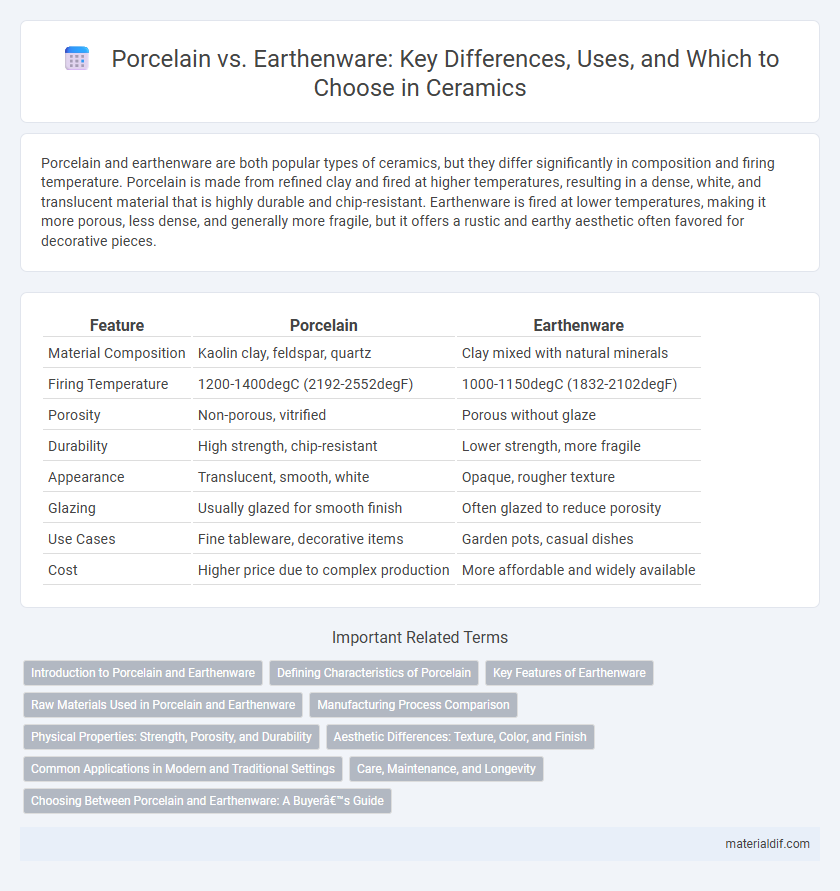Porcelain and earthenware are both popular types of ceramics, but they differ significantly in composition and firing temperature. Porcelain is made from refined clay and fired at higher temperatures, resulting in a dense, white, and translucent material that is highly durable and chip-resistant. Earthenware is fired at lower temperatures, making it more porous, less dense, and generally more fragile, but it offers a rustic and earthy aesthetic often favored for decorative pieces.
Table of Comparison
| Feature | Porcelain | Earthenware |
|---|---|---|
| Material Composition | Kaolin clay, feldspar, quartz | Clay mixed with natural minerals |
| Firing Temperature | 1200-1400degC (2192-2552degF) | 1000-1150degC (1832-2102degF) |
| Porosity | Non-porous, vitrified | Porous without glaze |
| Durability | High strength, chip-resistant | Lower strength, more fragile |
| Appearance | Translucent, smooth, white | Opaque, rougher texture |
| Glazing | Usually glazed for smooth finish | Often glazed to reduce porosity |
| Use Cases | Fine tableware, decorative items | Garden pots, casual dishes |
| Cost | Higher price due to complex production | More affordable and widely available |
Introduction to Porcelain and Earthenware
Porcelain is a type of ceramic made from refined clay fired at high temperatures, resulting in a durable, translucent, and non-porous material known for its strength and fine texture. Earthenware, in contrast, is fired at lower temperatures and remains more porous and less durable, often featuring a coarse texture and a rustic aesthetic. Both materials have distinct properties that influence their usage in pottery, tableware, and decorative arts.
Defining Characteristics of Porcelain
Porcelain is a ceramic material known for its high density, translucency, and strength, achieved through firing at temperatures between 1,200degC to 1,400degC. Unlike earthenware, which is more porous and fired at lower temperatures, porcelain's vitrification process creates a non-porous, glass-like surface that resists chipping and moisture absorption. The fine-grained composition of kaolin clay and other minerals contributes to porcelain's smooth texture and delicate appearance while maintaining exceptional durability.
Key Features of Earthenware
Earthenware is a porous ceramic fired at lower temperatures, typically between 1,000degC and 1,150degC, resulting in a softer and more porous body compared to porcelain. It is characterized by its rich, earthy colors, often reddish or brownish due to iron content, and is usually glazed to make it waterproof. While less durable and more prone to chipping than porcelain, earthenware remains popular for decorative pottery and rustic tableware because of its warmth and tactile quality.
Raw Materials Used in Porcelain and Earthenware
Porcelain is made from a refined mixture of kaolin, feldspar, and quartz, creating a dense, white, and translucent material fired at high temperatures above 1,200degC. Earthenware uses clay-rich materials with higher levels of iron and impurities, resulting in a porous, opaque body fired at lower temperatures between 1,000degC and 1,150degC. The purity of raw materials in porcelain contributes to its durability and fine finish, whereas earthenware's coarser clay composition gives it a more rustic texture and greater porosity.
Manufacturing Process Comparison
Porcelain is made from refined kaolin clay, fired at extremely high temperatures between 1,200degC and 1,400degC, resulting in a dense, vitrified, and translucent material. Earthenware, composed of natural clay fired at lower temperatures around 1,000degC to 1,150degC, remains porous and less durable without a glaze. The manufacturing process differences impact the final product's strength, translucency, and suitability for functional versus decorative uses.
Physical Properties: Strength, Porosity, and Durability
Porcelain exhibits superior strength and low porosity, resulting in high durability and resistance to chipping, while earthenware is more porous, making it less durable and more prone to absorbing liquids. The vitrification process in porcelain creates a dense, glass-like structure that enhances its mechanical properties compared to the coarser, more fragile composition of earthenware. Consequently, porcelain is preferred for applications requiring toughness and water resistance, whereas earthenware serves better in decorative or low-stress uses.
Aesthetic Differences: Texture, Color, and Finish
Porcelain features a smooth, glass-like finish with a translucent, white or slightly off-white color that emphasizes fine details and delicate designs. Earthenware typically has a coarser texture with a matte or slightly rough finish, exhibiting earthy tones like red, brown, or beige that underscore its rustic charm. The refined, polished surface of porcelain contrasts sharply with the organic, tactile quality of earthenware, influencing their aesthetic appeal in ceramic art.
Common Applications in Modern and Traditional Settings
Porcelain is widely used in fine dinnerware, decorative objects, and laboratory equipment due to its strength, translucency, and low porosity, making it ideal for both modern and traditional applications. Earthenware, characterized by its porous and more fragile nature, is commonly employed for rustic pottery, garden planters, and artisan tableware, reflecting traditional craftsmanship and everyday utility. Both materials serve distinct roles in ceramics, with porcelain favored for durability and elegance, while earthenware is preferred for affordability and artisanal appeal.
Care, Maintenance, and Longevity
Porcelain requires gentle handling and non-abrasive cleaning to maintain its smooth, vitrified surface and prevent chipping, making it highly durable and stain-resistant over time. Earthenware is more porous and delicate, needing careful drying and sealed glazing to avoid moisture absorption and cracking, which shortens its lifespan if neglected. Consistent, proper care enhances the longevity of porcelain, often lasting decades, while earthenware demands more frequent maintenance to preserve its structural integrity.
Choosing Between Porcelain and Earthenware: A Buyer’s Guide
Porcelain offers high durability, non-porous surfaces, and a fine, translucent finish ideal for elegant dinnerware and intricate decorative pieces. Earthenware is more porous, less dense, and typically handcrafted, providing rustic charm at a lower cost but requiring careful sealing to prevent moisture absorption. Buyers prioritizing longevity and a glossy finish should choose porcelain, while those valuing affordability and a natural, earthy aesthetic may prefer earthenware.
Porcelain vs Earthenware Infographic

 materialdif.com
materialdif.com